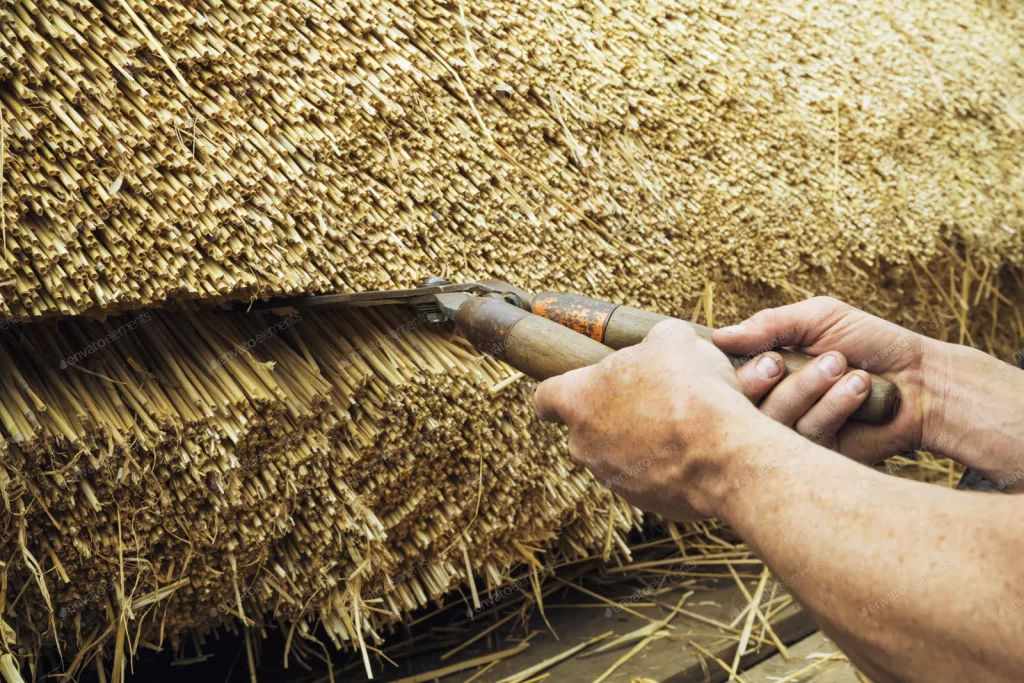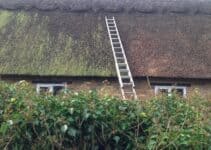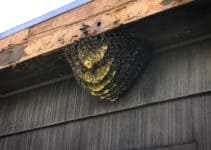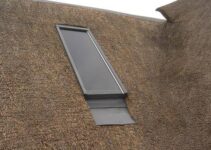In the UK, thatched roofs are generally made from these three main materials:
- Water reed
- Combed wheat reed
- Long straw
Thatch Roofing Material
As well as the above, there are many less common thatch roofing material options, such as:
- Turf
- Sedge
- Heather
- Rye Straw
- Marram Grass
- Veldt Grass
- Tiles
Some of these thatched roof materials have declined in popularity over time, while others have become almost extinct.
An overview of each of these thatching options can be found in this article, including where and when they might be used and the potential benefits and disadvantages of working with them.
What Are Thatched Roofs Made of In England?
There are a number of options for thatched roof materials in England. While some are more prevalent than others each type of thatch material offers their own benefit.
Reed
For hundreds of years, reed has remained a popular choice for thatched roofs. In the past, this attractive and durable material was readily available in many places throughout Europe.
Water reed could be found close to almost any river, while combed wheat reed was a key feature of agricultural areas.
Water Reed
This thatch material, as its name suggests, is sourced from the reed beds around rivers. It can originate from countries as far apart as France, China and the Ukraine, amongst many others.
Because of these varying origins, water reed supplies can differ greatly in length, diameter and taper, meaning that a thatcher must take care to use the right water reed and tools for the job in hand.
Norfolk Reed is produced in the Norfolk Broads area. Due to the cost of its production and restrictions on its harvest, there is a shortage of UK-grown water reed.
The vast majority is now imported, and water reed brought in from abroad is often less durable than the homegrown variety.
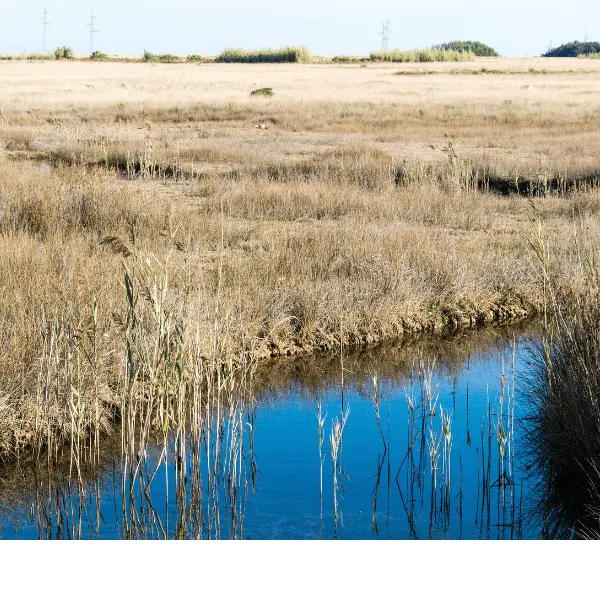
Combed Wheat Reed
Also known as Devon reed, this thatching material was traditionally a by-product of the cereal growing process. Nowadays, short straw is used in cereal production instead, and is unsuitable for use on thatched roofs.
The evolution of the farming industry and the introduction of combine harvesters in the 1930s has also diminished the availability of combed wheat reed, while chemical fertilisers used in agriculture have impacted on its strength and longevity.
Only a few specialist producers of this thatched roof materials are left in the UK, along with a handful of thatchers who grow it for their own use.
In the harvesting process, the growers must use binders, threshing machines and combers. This machinery can often be very old, making the production of combed wheat reed somewhat time-consuming.

Long straw
This variety of straw is grown specifically for use on thatched roofs. It gives a rugged and shaggy appearance compared to reed.
This is because both ends of the straw roofing material– the ears and the butts – can be seen.
Long straw is generally produced and harvested in a very similar way to combed wheat reed, although knowledge and experience are necessary in order to select the right straw, which can neither be too wet nor too dry.
Long straw used to be the most popular material used in thatching, but it now trails behind the two reed varieties.
Turf
This versatile option involves using strips of grass to create a waterproof thatched roof.
Turf was once a very popular choice, but its use has diminished over time, in favour of other materials.
There are a couple of possible reasons for this, such as the time and effort needed to cut the strips of turf and the relatively untidy appearance compared to that of reed or straw.
Turf thatching in the UK has traditionally been a distinctly northern technique, with possibly the best-known example of this being the Robert Burns Cottage in Ayr, Scotland.
Turfing is often still used in other European countries, such as Norway and Denmark.
Sedge
Sedge looks very much like pampas grass. As with turf, sedge roofs are most commonly found in northern Britain.
It’s a good option due to its strength and durability, but sedge is often disliked by thatchers because of its characteristic sharp edges. In the UK, sedge is the preferred material for sealing and finishing the ridge of a thatched roof.
Heather
Traditionally, this was a particularly popular choice in Scotland, where heather of the right length for thatching (around four feet) can be found growing wild on the slopes of the Highlands.
In fact, there are millions of acres of heather throughout Scotland. With the decline of thatched roofing, large areas of this heather are now burned regularly to keep the plant under control.
This choice of thatched roof offers a distinctive colour and a picturesque appearance. A couple of layers of turf must sit beneath the heather, to absorb any rain that manages to penetrate this “wavy” material.
Rye Straw
Amongst thatchers, rye straw is widely known as a soft thatch material. Because it’s less durable than other materials, it is often used as a base layer on thatched roofs in the UK.
Rye straw is, however, popular in other European countries, such as Ireland. For centuries, inhabitants of the Aran Islands have grown rye crops for the purpose of thatching the roofs of their cottages.
This tradition is now diminishing as less and less thatched homes remain occupied.
Marram Grass
Marram Grass roofs are characteristic of coastal cottages, specifically those found in exposed areas.
This material can tolerate very high winds, often containing sand, but the thatching needs to be checked every few years to make sure it is still intact.
In the past, Marram grass was used in many places, including Wales, Ireland and even Scandinavia. These days, one would have to visit the Scottish Hebrides to see this type of thatched roof.
Veldt Grass
Similar in appearance to water reed, veldt grass is a popular thatching material in the UK. It has been used successfully on many properties, but the downside is the high costs associated with producing and transporting it.
The expense of thatching with veldt grass has caused a huge decline in its use.
Tiles
Although not strictly a thatching material, tiles are often used to line the ridges of water reed roofs. This is a popular choice throughout Europe, where semi-circular clay tiles create a distinctive appearance, unlike that of a traditional British thatched cottage.
What’s Under a Thatched Roof?
Under a thatched roof, you’ll primarily find a layer of waterproofing material and the structure’s framework. The waterproofing layer is often comprised of modern materials like felt or rubber membrane, and is necessary to prevent water from penetrating the inner layers.
Directly beneath the waterproofing is the roof structure, typically made of timbers, that provides the necessary support for the thatch. The roof structure may also contain insulation for temperature regulation. Additional elements, like a fireproof barrier, can also be included for added safety.
The specific materials and design may vary depending on local traditions and building codes, but these fundamental components remain consistent.
What Is A Thatched Roof Made Of?
In conclusion, thatched roofs, an age-old roofing technique, have stood the test of time, offering a unique combination of natural beauty, eco-friendliness, and functionality.
Made primarily from materials such as water reeds, long straw, and combed wheat reed, thatched roofs not only blend harmoniously with the surrounding environment but also provide excellent insulation and weather resistance.
The remarkable longevity of these roofs, when maintained properly, is a testament to their durability and resilience.
